The Itinerary: Our Morocco Desert Trip
While we prefer to travel independently, there are times when a guide and someone to organize things for you is appreciated. This tour one of those times. If you keep reading until the end of the article I share all the reasons we did a tour and tell you if I would do it again. But for now, grab a drink, sit back and enjoy the journey through the Moroccan desert with us.
Day 1: The High Atlas Mountains, the Kasbah and the Hollywood of Africa
Our guide Abdul met us promptly at 8:00 am at our hotel. As we set off on our drive, we did the usual get-to-know-you-chit-chat. Our first few stops of the day were for photos. It soon became obvious one of the advantages of a guide was he knew all the picture spots and where to get the best view and angle. Fantastic. The drive winds through the High Atlas Mountains, crosses Tizi n’Tichka Pass and continues to Ouarzazate offering some great picture spots. Not driving means we can both just enjoy the views.
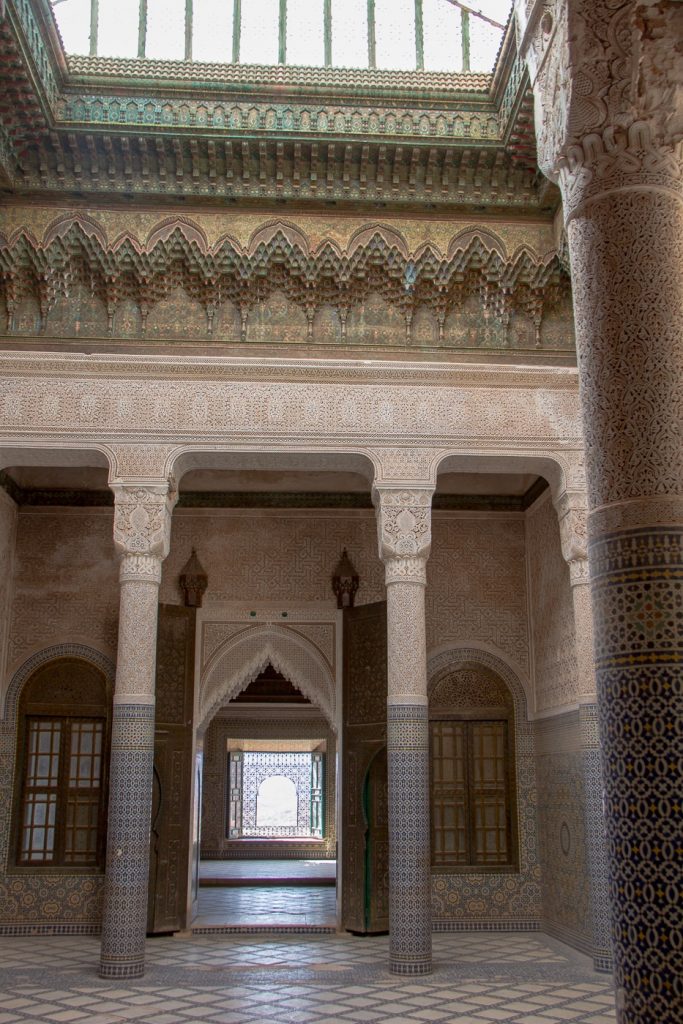
Telouet Kasbah
Turning off the main road onto a secondary road we head for our first official stop, Telouet Kasbah. The secondary road to the Kasbah was under construction. Major construction making for a slow trip requiring a four-wheel drive. A peaceful protest was in progress with most of the town walking along the road providing an opportunity to people watch.
Upon arrival at the Kasbah, our guide, Rashedi, was ready and waiting for us. I am sure many visitors pass by and never know about the history of the Kasbah and its owner, but it has all the makings a of a Hollywood blockbuster! Money, women, and of a course the villain, a traitor to the king no less.
The Telouet Kasbah was along the very prosperous trade routes running through the Sahara Desert to the coast, and near a major salt mine which at the time was a very valuable commodity often exchanged as payment (this is where the term salary originates.)
The abandoned building is the third Kasbah to be built on the site by the El Glaoui family. Even from the current state of disrepair the splendor of the building is evident. The workmanship including carved stucco walls, beautiful tile mosaics and carved cedar wood ceilings took over 300 craftsman more than three years to make.
Given the lack of maintenance, the current condition of the building, is a testament to the quality of the craftsmanship. The work, using traditional techniques, includes tempura, which uses egg whites, as varnish to ‘fix’ the paint on the wood. The elaborate plaster work is stucco, a combination of egg shells, gypsum and crushed marble, carved while still wet. All designs were created from memory.
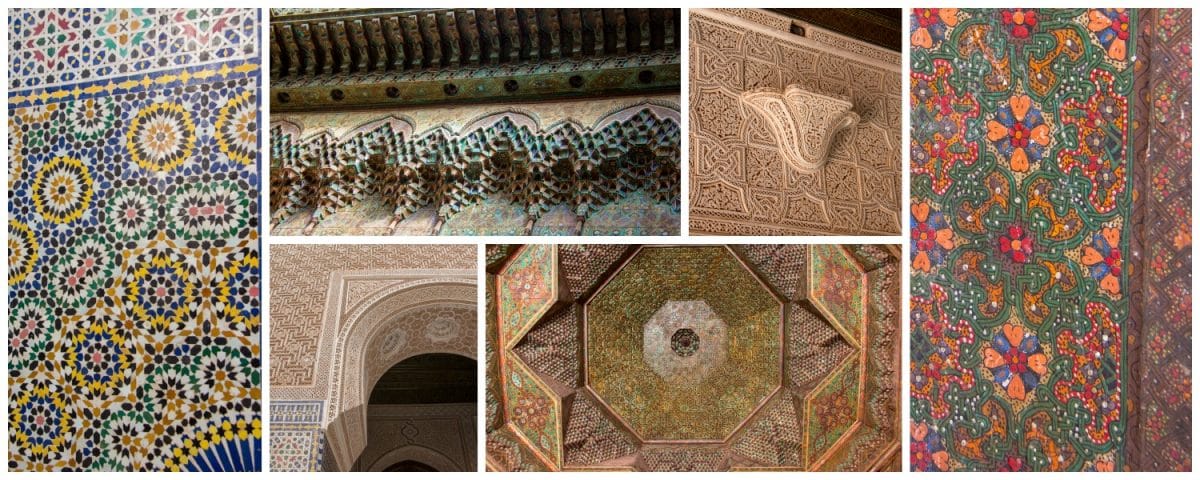
Lord of the Atlas- the Pasha of Marrakech
The Pasha, a powerful representative of the government, with the authority to collect taxes from the caravans lived here with his family, 5 official wives (2 Turkish and 3 Moroccan) and 80 concubines. In Morocco’s feudal government, the pasha functions like a duke or bishop in the English system. From 1912 to 1956, Thami Glaoui ruled as the Pasha of Marrakech, one of the most powerful positions in the country which earned him the nickname, “Lord of the Atlas”.
During French rule, the Pasha’s position as a representative for the Sultan, enabled the Glaoui family to amass considerable wealth. El Glaoui supported the French to exile the Sultan and replace him with a French figurehead. When opposition to French rule grew within Morocco and the exiled Sultan returned to power, El Glaoui was ousted as a traitor. His life was spared but all the family assets were seized. Telouet Kasbah has remained abandoned since.
If you would like to learn more about this time in Moroccan history, Lord of the Atlas, by Gavin Maxwell, is a historical account of the Glaoui family interwoven with Morocco’s journey toward independence.
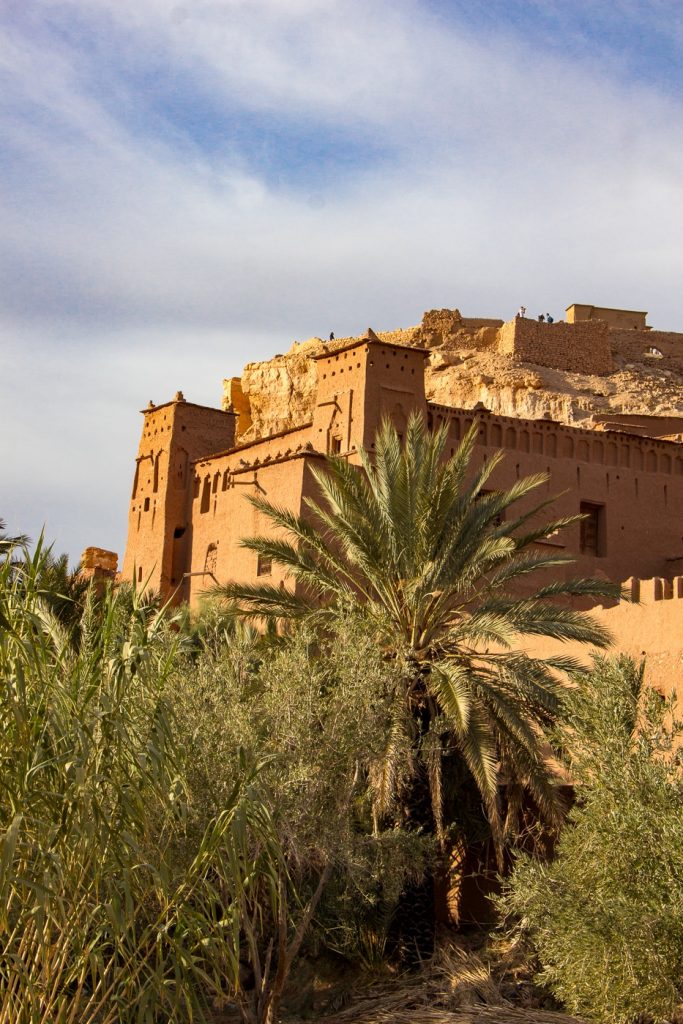
Ait Benhaddou: The Hollywood of Africa
After all that drama and intrigue, and a quick lunch at Café Auberge, we headed onward to Ait Benhaddou, which is the epicenter of the film industry in Morocco. A UNESCO World Heritage site, Ait Benhaddou Kasbah, known as the Hollywood of Africa dates from the 11th century when it was a caravanserai, or inn for the caravans traveling this trade route. Gladiator, Lawrence of Arabia, Jesus of Nazareth and Jewel of the Nile were all filmed here. Game of Thrones has also filmed here.
A few families still live within the original walls of the Kasbah and there are a few shops. The Kasbah is generally thought to be much as it would have been in the 11th century.
We spent the night in Ouarzazate (the pronunciation of which sounds remarkably like “where’s that.”)
Day 2: Ouarzazate to the Todra Gorges
Today we head for Todra Gorge, traveling through the oasis of Skoura and the Valley of the Roses along a road known as the Road of 1000 Kasbahs, and yes, we are stopping at one final kasbah, Kasbah Amridil for a tour, with our guide Reda.
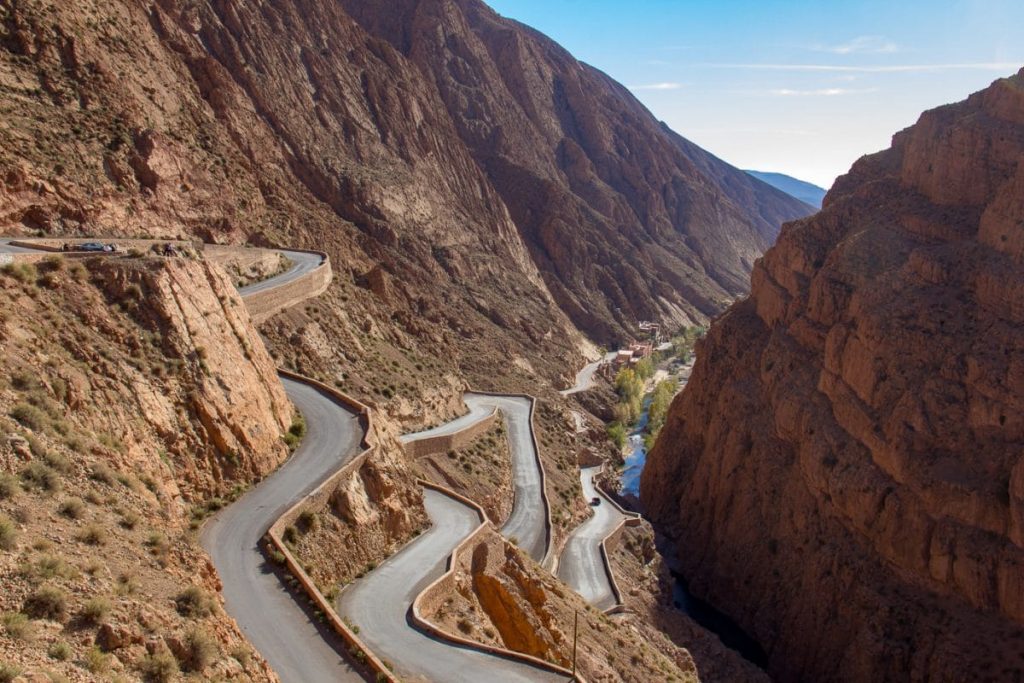
Kasbah Amridil
Having been in the same family for over 300 years, the family uses its own money, and money from admission fees to maintain the property. Kasbah Amridil provides an opportunity to understand daily life in the Kasbah and a bit more about how it was constructed.
Some of the interesting facts from Kasbah Amridil:
- It has multiple kitchens used at various times of the year depending on the weather. Some kitchens are good for heating the house in winter, others are better suited for summer as they don’t warm the house too much!
- The first stair is always very high to keep the animals from entering the house. In the winter the animals stay inside for protection from the weather. The body heat from the animals helps heat the house.
- There are two different bread ovens – one resembles a wood fired pizza oven and the other is shaped like a tandoor oven.
- The well inside the kasbah prevents the water supply being attacked or poisoned.
- The olive press is flat wooden slats- unlike the wheels used to press olives in Italy and Greece.
 Construction of the Kasbah:
Construction of the Kasbah:
- The Kasbah is thermal neutral with the construction method similar to building a straw bale house. Mud and hay compacted into a wooden frame then covered on the outside with a mud/clay mix.
- Bamboo scaffolding was used to build the walls upward. The holes you see in the walls remain from the scaffolding.
- Bamboo reeds make the floors and ceiling because they were strong, lightweight and flexible enough to accommodate the occasional shift in the building or earthquake.
- People lived together in the Kasbah for security and much of the design makes it easier to defend; the stairs are uneven, and the doorways built low and at random heights. The residents used to the quirks navigate with no problem, but invaders are at a disadvantage.
- Wrought iron on the windows provides privacy, allowing woman to watch from inside the house and not be seen.
We noticed many of these oddities in other Moroccan buildings and just assumed poor construction, now we know many of these things were intentional and for good reason!
The owner of the Kasbah is from what is now present-day Yemen. A religious and knowledgeable man, he served as the local judge settling disputes among the villagers in a small room at the front of the house where he could hear cases.
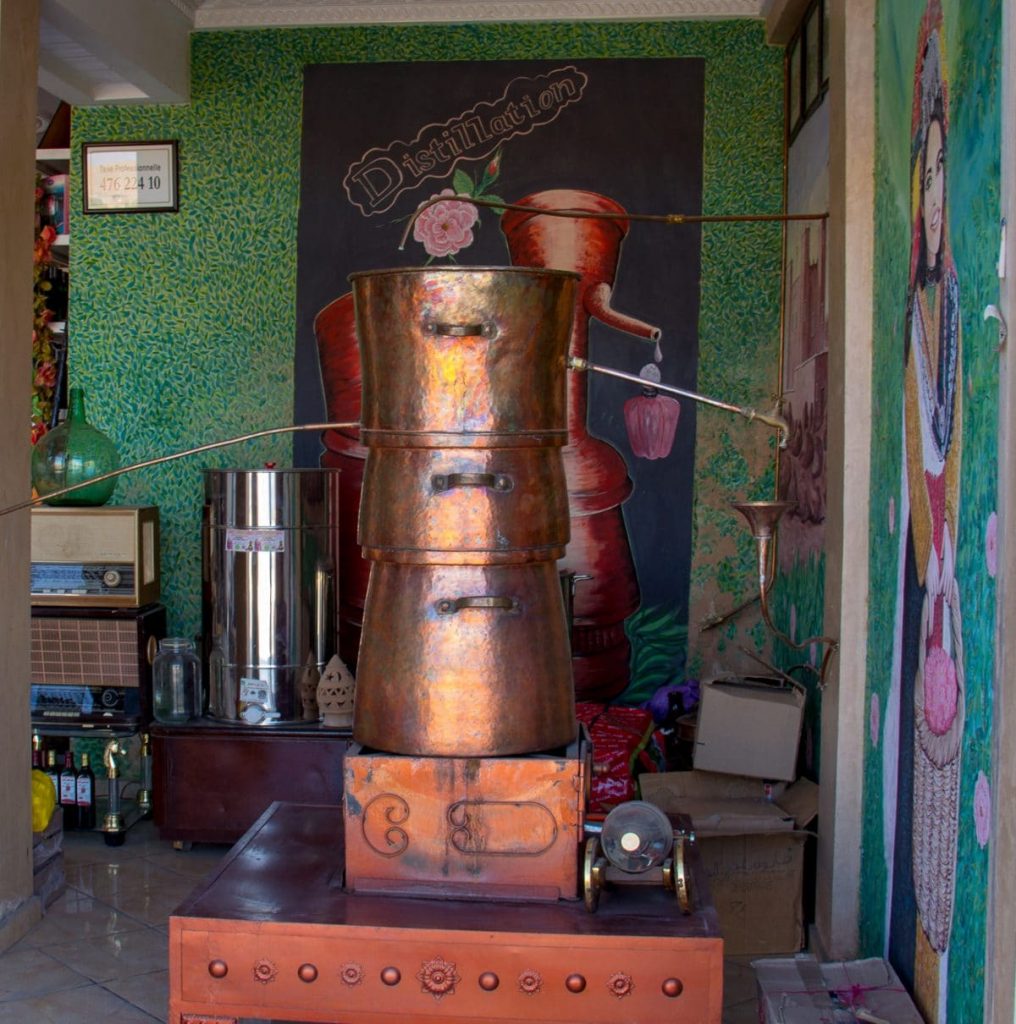
The Valley of the Roses
The drive through the Valley of the Roses toward Dades Gorge passes through rich farm country where many dates, figs and almonds grow.
The Valley of the Roses receives its name from the roses farmed here to make rose water and rose oil used in the cosmetics industry. At a quick stop for a drink, we see the distillery for making rose oil, it looks the same as one for distilling alcohol!
A Visit to a Berber Home for Tea
I haven’t mentioned it yet, but Abdul our guide is a Berber, and he knows everyone. We keep randomly running into people he knows, many of them from his village. He is also well organized with the local guide ready and waiting at each stop. Following our drink stop in the Valley of the Roses we head off road into what looks like the middle of nowhere, to have mint tea in a Berber home. Their home is a cave.
While Berbers are referred to as Nomads, and identify as nomads, the communities are no longer nomadic moving from place to place. Most stay in one location or may shift to a second location for winter/summer, a second home if you will.
The Berber 4×4, the family donkey, is for most families the main form of transportation for both people and goods. Each week the family and donkey go to the market for supplies. Each family will have their own cow, goat, chickens and a vegetable garden. Any surplus they may have is traded at the market for flours and other necessities.
The Berbers living in these caves have a tough life and a very quiet, basic existence. On day 3 of our trip we visit a Berber household for lunch in a traditional Berber village. I’ll talk more about the Berbers and their customs in that article.
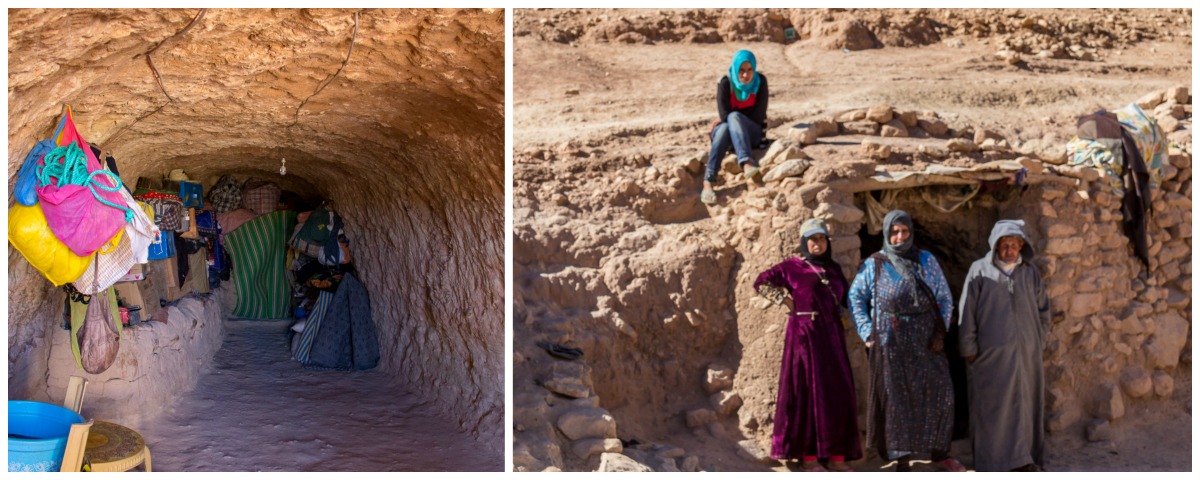
Lunch at Café Sindibad
Next stop is for lunch at a small local café, Café Sindibad. Here are contact details as this is where local knowledge is essential. If you want to eat here, call +212 6 70 72 26 00 and make a booking. They make authentic tagines. If you recall from our Essaourira article, cooking in a tagine is a slow cooking method. Your lunch will be started early in the morning, so it is ready for your arrival.
Mostly locals eat here, because they know to call ahead. Now you have the details so if you are in the area (Google maps: Café Sindibad Dades Gorge, is about KM 25 on the road to Dades Gorge) and would like an authentic tagine, call and book your tagine.
Lunch was three courses; salad, chicken and vegetable tagine with preserved lemon, crème caramel flan with pomegranate and herbal tea. The meal was excellent. Total bill 200 dirhams or 20 euros.
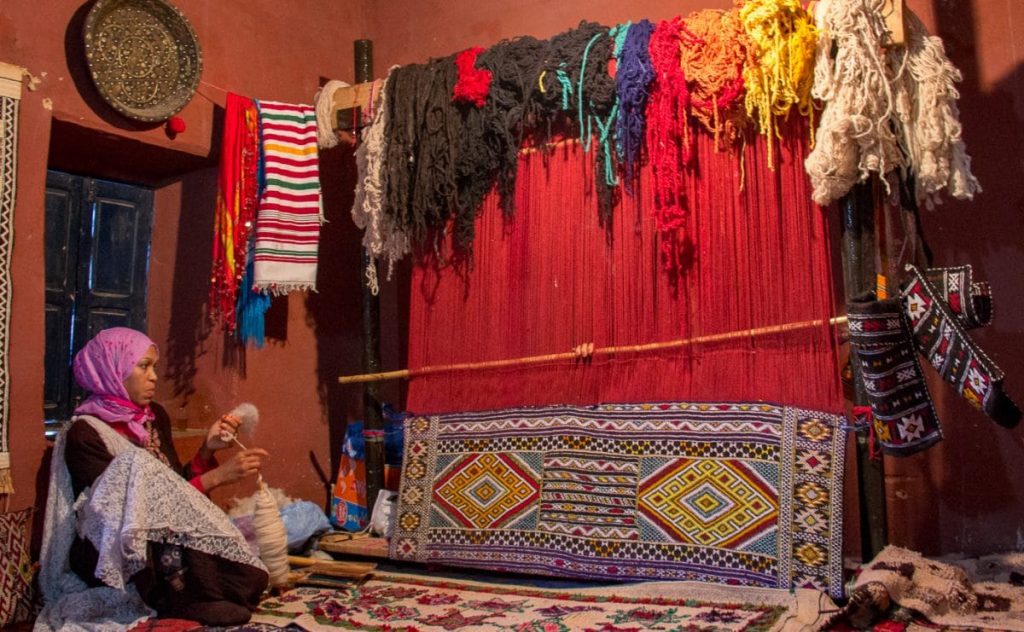
Handmade Moroccan Rugs
After lunch, we went to learn more about Berber culture and rug making with a stop at the local rug cooperative in Tinghir. A cooperative of local Berber ladies making traditional Berber rugs as a source of income.
The rug cooperative in Tinghir offers the perfect place to learn about Moroccan rugs. We also urge you to read our guide to buying a Moroccan rug to learn more about the materials, patterns and prices off Moroccan rugs.
There is no pressure to buy a rug during your visit to the rug cooperative. You can just learn how rugs are handmade in Morocco, take photos, enjoy a mint tea and continue your journey. There is no actual shop at the coop and they view their role as one of education to visitors as well as providing an income to the ladies in the community. Many of the rugs made at the cooperative are sold to other shops in Morocco.
If you are interested in purchasing a rug from the coop, all the rugs have price tags. I get the impression this is the wholesale price they would sell the rug to the shop. The price reflects a fair value to the lady making the rug and all the income stays in the community. They ship around the world or package your rug for you to carry.
The gentleman running the coop is Razouk El Mahjoub. The name of the coop: Tissage Des Tapis Berbere Nomade which roughly translates to “Weaving of Nomadic Berber Rugs”. It is in Tizgui, Tinghir. It appears on Google maps as the “Carpet Cooperative” if you enter “Tizgui, Tinghir “- the description of the location on his business card is 13 km from Tinghir and 600 m from Todra Gorge. You can contact Razouk at +212 6 424 78 527 or 0627 566 647, or by email berbere.nomode.todra@ hotmail.com (no space before the hotmail.com)
Day 2 ends at our hotel in Todra Gorge, a stunning rock gorge known for rock climbing.
Day 3: Visiting a Traditional Berber Home
Today we visit our guide, Abdul’s family home for lunch. His mother, Hanu and several of his siblings are hosting us for a traditional Berber lunch of couscous and a lamb tagine.
I have written a separate account of the day and you can find it here.
Day 4: From Todra Gorge to Erg Chebbi and the Merzouga Dunes
We set off this morning from Todra Gorge. Already there are a lot of climbers on the walls of the canyon. I decided as we exited the Gorge, driving by other hotels, we stayed in a great spot. Le Festival Hotel was in a nice quiet spot, in the gorge but away from the busier, congested section of the gorge.
As our hotel is the only building around, the lack of lights and noise meant phenomenal views of the night sky from the decks at the hotel. Our room, one of the cave rooms at the hotel, was quiet and dark, perfect for a good night’s sleep. And the shower, hot with fantastic water pressure, was most welcome to wash away the dust from a day of sightseeing in the desert!
In addition to rock climbing there is great hiking in the area, some of the trails begin walking distance from the hotel.
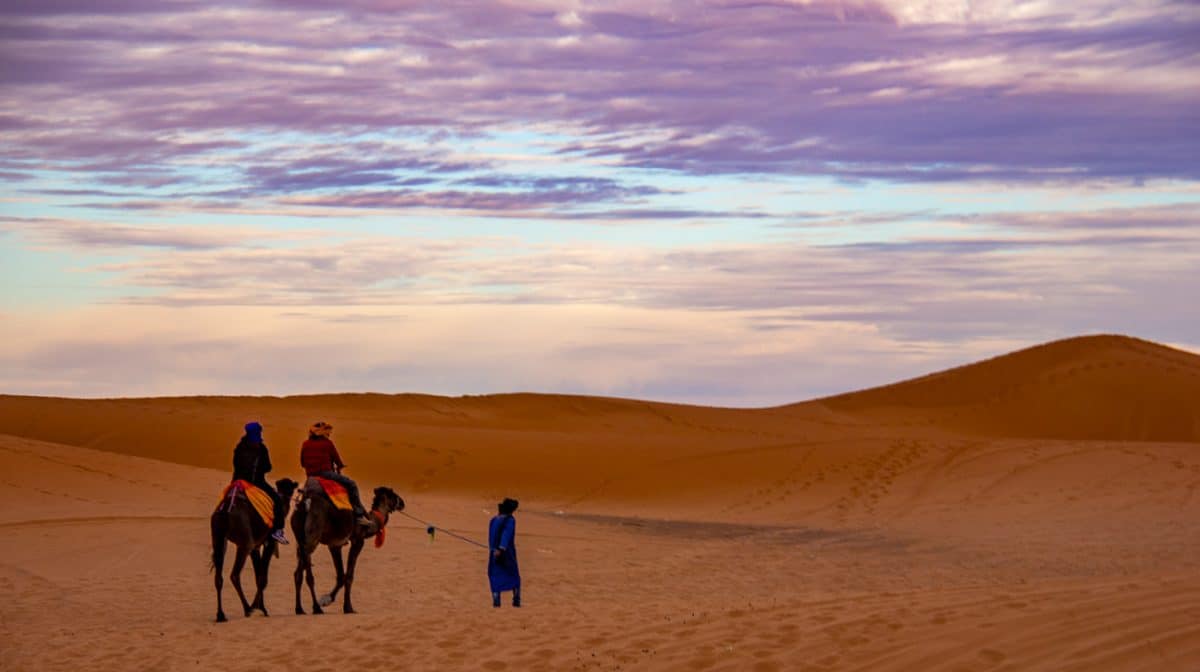
Our destination for the day; Erg Chebbi in the Sahara Desert of Morocco, the starting point for our camel ride to spend the night in the desert!
One stop along the way, just after Erfoud on the way to Merzouga, which I found fascinating was to see the old underground irrigation channels built to supply water to nearby towns and for agriculture. One of the surprises from traveling through the Atlas Mountains and the desert is water. If you dig down, there is water, and many homes and agriculture appear in the middle of the desert with trees and lush fields or gardens. An underground aquifer supplies water.
To take advantage of the water, and reduce evaporation, an ingenious irrigation system transported water for drinking and farming 7 kilometers from the oasis. Stopping along the road, at one of the wells, you go underground to see the now disused series of wells and walk along the underground water channel. Constructed at a slight angle, the channels use gravity for the water to flow downhill. Necessity is the mother of invention! Very clever.
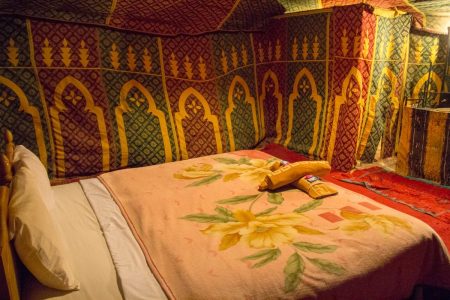 A Night in the Desert
A Night in the Desert
The last night of our trip, we spent at a luxury Morocco desert camp in the Merzouga Dunes. Leaving the bulk of our luggage and our guide at the Auberge du Sud Hotel, we took a small overnight bag and mounted a camel for a 1.5 to 2-hour ride into the desert to the tented camp.
A permanent tent, complete with bed, toilet and shower inside, was to be our room for the evening.
Setting out a couple of hours before sunset, the scenery, was the highlight of the journey. Unfortunately, we missed sunset, arriving about 10 minutes too late, but it was still spectacular.
We had been on a camel before, and I had remembered correctly, they are not very comfortable to ride! After our short journey I was ready to arrive and get off the camel!
We introduced ourselves to the other guests and sat around having a chat in the remaining light. Dinner was served in a dining tent. The meal was good and the food plentiful. No alcohol is available for purchase, but you can bring your own.
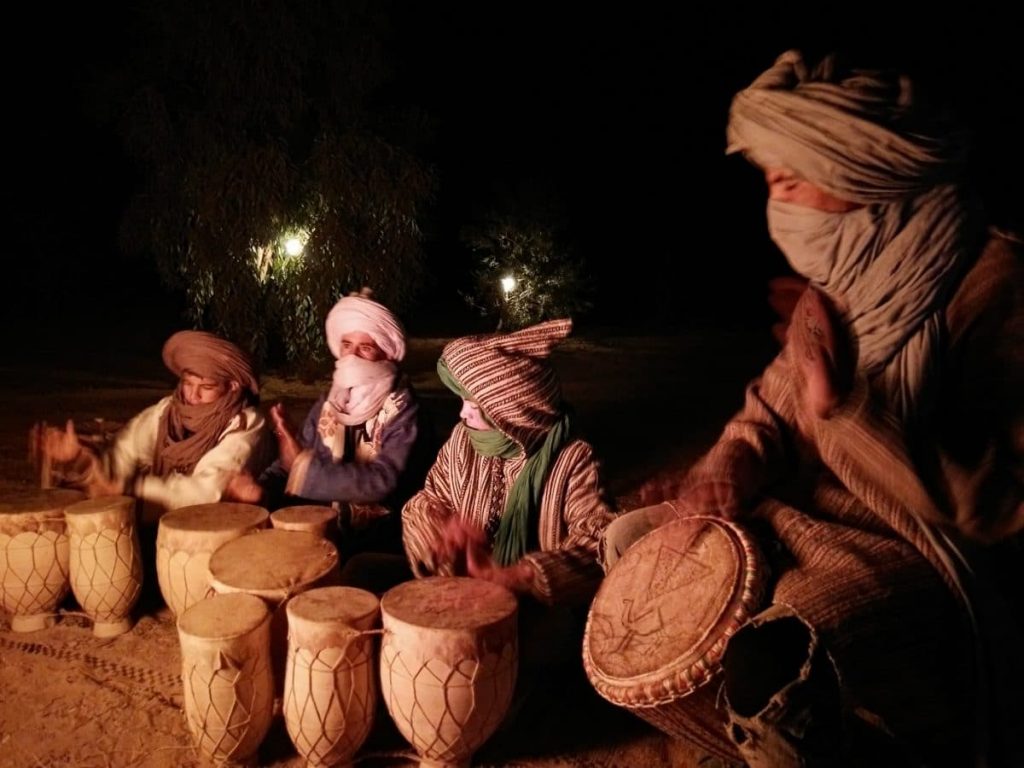
After dinner the boys at the camp played drums while we sat around a small fire. As there is little wood available in the desert, this ended all too early and we were off to bed. Unfortunately for us, it was a cloudy night and there were no stars. Luckily, the previous night in the Todra Gorge we had spectacular night views so at least we had the opportunity to enjoy the stars.
We were up early, at 6:20 am, to climb the nearby sand dune to witness sunrise. Simply stunning, the colors of the dunes change dramatically as the sun rises. Breakfast followed, and we mounted our camels for the leisurely return ride. I am not sure whether the colors of the desert were more spectacular in the morning or the evening.
Day 5: Erg Chebbi to Fez
Sadly, this is our last day, by tonight we will be in Fez (or Fes).
Leaving the Moroccan desert, we drive through the Ziz Valley an area known for its palm plantations. There were numerous picture stops and a stop for lunch.
Our last stop before Fez was in Ifrane, known as “little Switzerland”. The trees and alpine architecture here is unlike any in Morocco. In the Middle Atlas Mountains at an altitude of 1,665 m (5,463 ft) Ifrane is home to a ski resort and a large cedar forest. It also has a large university and many expats live here.
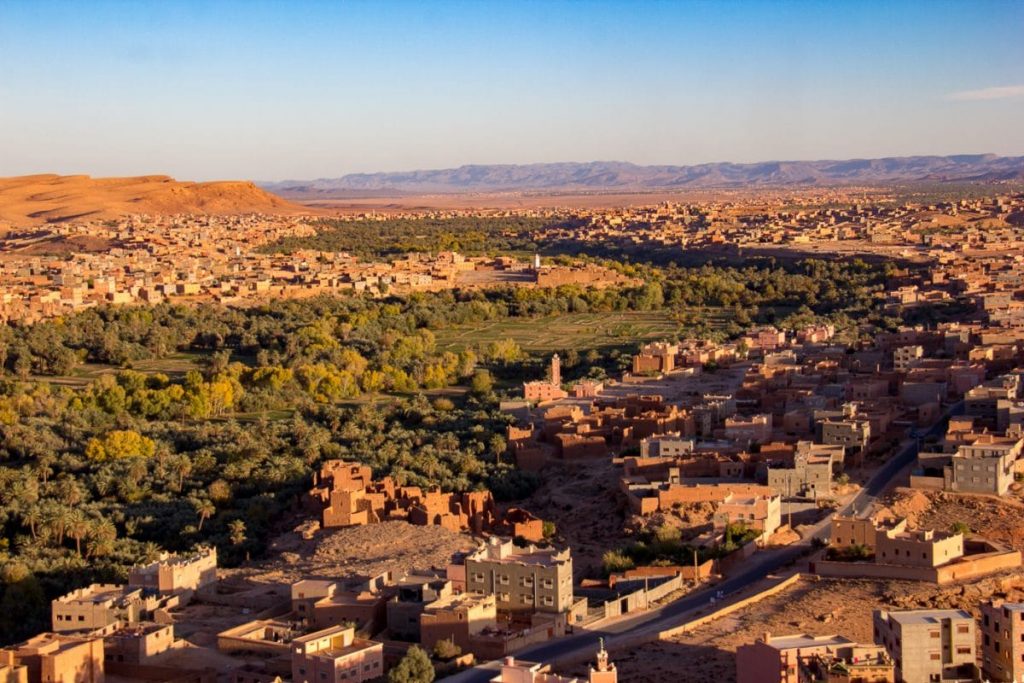
Why Take a Tour of the Moroccan Desert?
We met many people on self-drive trips through the desert, and we considered it. In the end we decided to do a tour for a few reasons:
- We wanted a 4X4 and to go some places where a 4X4 was required. Renting one can be expensive and often if you read the fine print you can’t use one off-road anyway, being restricted to paved roads which defeats the purpose of renting a 4X4 in my opinion.
- We really wanted to explore the Berber culture and have access to some things just not available to independent travelers.
- The culture and landscape were unique and different to other parts of the world we have traveled so we decided we would benefit learning from a guide.
- It doesn’t cost much more than organizing it yourself, so the slight additional cost was more than worth it.
On the occasions we take short tours, we still prefer a private tour to a small group. Whenever possible we select a local company. We believe this results in a better experience as the perspective of a local is always different and we are interested in learning their perspective.
The money spent with a local company usually stays in and benefits the local community rather than paying marketing and salaries in a corporate office somewhere. We believe it is a more responsible way to travel. Supporting the local community and local business is the reason why we try to stay in local and/or family owned hotels when we travel rather than large international chains.
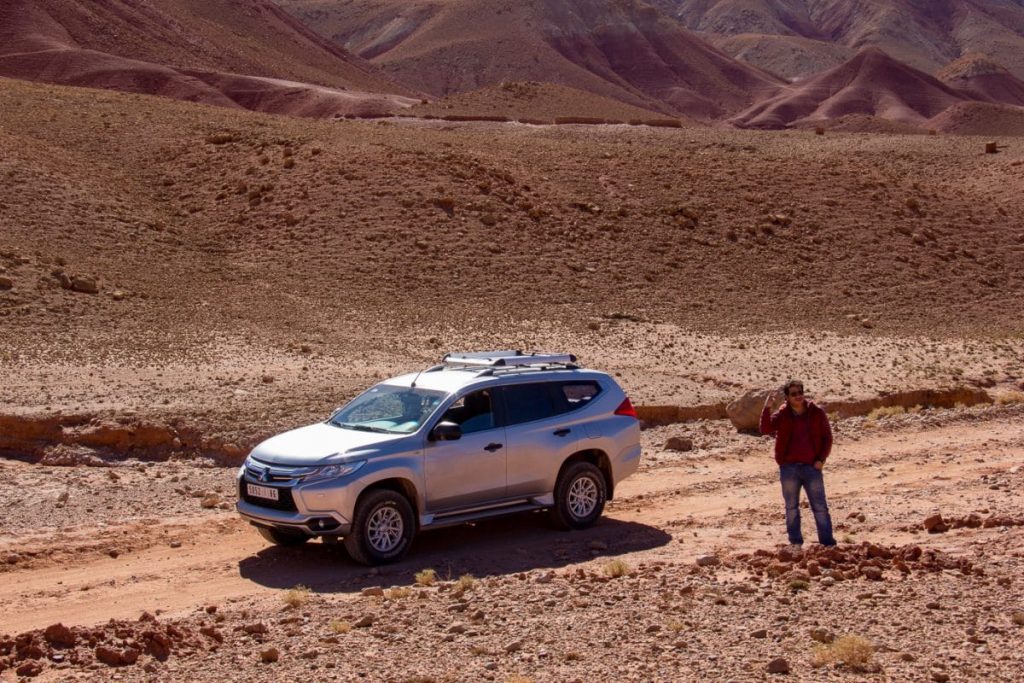
Authentic Berber Tours
We traveled with Authentic Berber Tours. Abdul, the founder and owner of the company was our guide. He was professional, personable, very knowledgeable and everything was well organized and ran to schedule.
Having been raised in a Berber village, he was able to explain firsthand about the life of a Berber. He and his family were generous to invite us to their home for a meal. It was a highlight of the trip and an experience we could never have had if we were traveling independently.
We were both able to relax and enjoy the trip, including enjoying the scenery along the way as neither of us was driving or navigating. Abdul knew everyone, including just running into people he knew along the way. His contacts and connections meant we had fantastic hotels rooms, great guides, excellent meals and access to places we would never even have known about, driving right by oblivious.
If you would like to go out to the Moroccan desert, I recommend going with a guide to get the most from the experience. I recommend Authentic Berber Tours without hesitation. They are an excellent local company, that will look after you and ensure you have the experience of a lifetime. It is easy to arrange a desert tour from Marrakech or Fez.
We traveled as guest of Authentic Berber Tours. All opinions are our own, based on own experience.



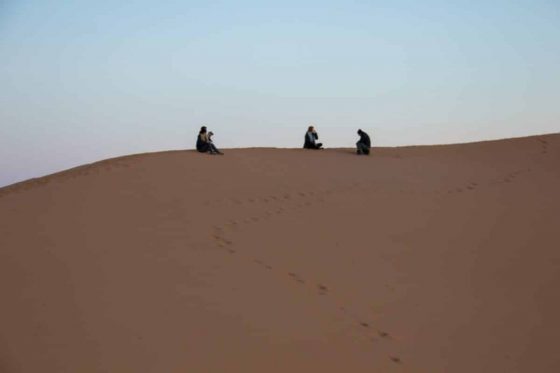

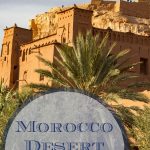
Leave a Reply